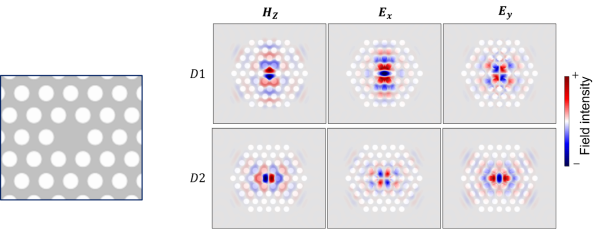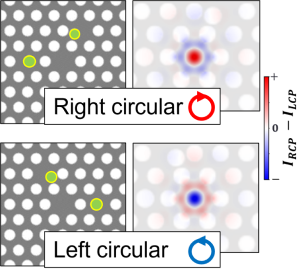Research:Chiral modes near exceptional points in symmetry broken H1 photonic crystal cavities
A 2-dimensional photonic crystal (PhC) consists of a lattice of air holes in a slab of material which gives periodic modulation of the refractive index. One air hole in the PhC is removed from the triangular lattice to form the H1 nanocavity which could confine optical fields and thus give rise to cavity modes. The traditional nonchiral H1 PhC cavity could support two degenerate and orthogonal linearly polarized dipole modes which can give rise to circular polarization when driven with a π/2 phase difference. However, fabrication error tends to lift the degeneracy of the modes making them impractical to generate circular polarization.

The photonic crystal cavity forms an “open boundary system” meaning the cavity could exchange energy with their surrounding environment via loss or gain. Such a system is also referred to as a non-Hermitian system. Peculiar degeneracies known as exceptional points (EPs) – at which both the eigenfrequencies and eigenstates become identical – could arise if a non-Hermitian system meets the right conditions. A broad sense of chirality can also be associated with EPs, for example circular polarization, chiral propagation and chiral geometric phase. We propose a scheme which makes use of non-Hermitian effects in a H1 PhC nanocavity to achieve intrinsic chiral cavity modes which are circularly polarized.
In our scheme, two selected air holes near the cavity are modified to induce non-Hermitian backscattering between the two modes. As the cavity modes approaches the EP with suitable air holes modifications, the modes become highly degenerate as well as chiral in nature. We confirmed such chirality by performing finite-difference time-domain (FDTD) simulations, showing that the dominant field intensity is circularly polarized with the degree of circular polarization approaching unity even in the farfield. The handedness of the chirality can be switched by selecting a different pair of air holes for modifications.

To learn more about this work, please refer to:
Chiral modes near exceptional points in symmetry broken H1 photonic crystal cavities
Phys. Rev. Research
3, 043096 (2021).
![]()